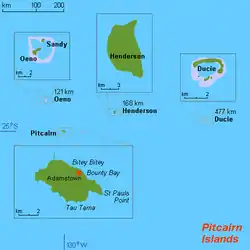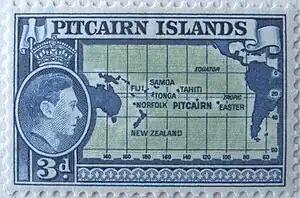Geography of the Pitcairn Islands
The Pitcairn Islands consist of four islands: Pitcairn Island (a volcanic island), Henderson Island (an uplifted coral island), and two coral atolls, Oeno Island and Ducie Island.

The only inhabited island, Pitcairn, has an area of 5 km2 (1.9 sq mi) and a population density of 10/km2 (26/sq mi); it is only accessible by boat through Bounty Bay. The other islands are at a distance of more than 100 km (62 mi).
Location

The Pitcairn Islands as a group of islands in Oceania:(25°04′00″S 130°05′00″W)
- Pitcairn Island (main island) (25°04′S 130°06′W)
- Henderson Island (24°22′01″S 128°18′57″W)
- Ducie Island (24°40′09″S 124°47′11″W)
- Oeno Island (23°55′26″S 130°44′03″W)
Situated in the South Pacific Ocean, about one-half of the way from Peru to New Zealand, they are one of the most remote sites of human habitation on Earth.[1][2]
The only inhabited island, Pitcairn, is at 25.04 south, 130.06 west. Pitcairn is about 2,170 kilometres (1,350 mi) southeast of Tahiti, 5,310 kilometres (3,300 mi) from Auckland, New Zealand, and over 6,600 kilometres (4,100 mi) from Panama.[3]
Area

- Total: 47 km2 (18 sq mi)
- Land: 47 km2 (18 sq mi)
- Water: 0 km2 (0 sq mi)
Pitcairn Island is about 3.2 kilometres (2.0 mi) long and 1.6 kilometres (0.99 mi) wide.[3] This is about 3⁄10 of the size of Washington, DC.
Land boundaries
0 km (0 mi)
Coastline
51 km (32 mi)
Maritime claims
Exclusive economic zone:
836,000 km2 (323,000 sq mi)
Territorial sea:
3 nautical miles (5.6 km; 3.5 mi)
Climate
The Pitcairn Islands have a maritime tropical rainforest climate (Af according to the Köppen climate classification), with the climate being warm and humid year-round, with no dry season. The warmest month in Adamstown is February, with a mean of 23.8 °C (74.8 °F), while the coolest month is August, with a mean of 18.5 °C (65.3 °F). The highest temperature recorded was 33.3 °C (91.9 °F) during March. Because of its maritime location, the temperature has never dropped below 10 °C (50 °F). Adamstown receives 1,543 millimetres (60.7 in) of rainfall annually, with the rain being evenly distributed across the year. The climate of the Pitcairn Islands is modified by southeast trade winds.
| Climate data for Pitcairn Island (1972-2004) | |||||||||||||
|---|---|---|---|---|---|---|---|---|---|---|---|---|---|
| Month | Jan | Feb | Mar | Apr | May | Jun | Jul | Aug | Sep | Oct | Nov | Dec | Year |
| Record high °C (°F) | 31.2 (88.2) |
32.4 (90.3) |
33.3 (91.9) |
30.7 (87.3) |
29.1 (84.4) |
31.3 (88.3) |
26.7 (80.1) |
26.7 (80.1) |
25.5 (77.9) |
27.8 (82.0) |
27.6 (81.7) |
29.3 (84.7) |
33.3 (91.9) |
| Average high °C (°F) | 25.7 (78.3) |
26.2 (79.2) |
26.1 (79.0) |
24.6 (76.3) |
22.9 (73.2) |
21.7 (71.1) |
20.8 (69.4) |
20.6 (69.1) |
21.0 (69.8) |
21.8 (71.2) |
22.9 (73.2) |
24.2 (75.6) |
23.2 (73.8) |
| Daily mean °C (°F) | 23.3 (73.9) |
23.8 (74.8) |
23.8 (74.8) |
22.5 (72.5) |
20.9 (69.6) |
19.7 (67.5) |
18.8 (65.8) |
18.5 (65.3) |
18.8 (65.8) |
19.6 (67.3) |
20.7 (69.3) |
22.0 (71.6) |
21.0 (69.9) |
| Average low °C (°F) | 21.0 (69.8) |
21.4 (70.5) |
21.5 (70.7) |
20.3 (68.5) |
18.9 (66.0) |
17.8 (64.0) |
16.9 (62.4) |
16.5 (61.7) |
16.6 (61.9) |
17.4 (63.3) |
18.6 (65.5) |
19.8 (67.6) |
18.9 (66.0) |
| Record low °C (°F) | 16.9 (62.4) |
18.0 (64.4) |
12.8 (55.0) |
15.0 (59.0) |
14.2 (57.6) |
11.7 (53.1) |
11.4 (52.5) |
11.6 (52.9) |
10.0 (50.0) |
10.2 (50.4) |
13.0 (55.4) |
13.5 (56.3) |
10.0 (50.0) |
| Average precipitation mm (inches) | 96.5 (3.80) |
132.7 (5.22) |
107.8 (4.24) |
114.8 (4.52) |
111.9 (4.41) |
152.8 (6.02) |
139.0 (5.47) |
131.6 (5.18) |
134.5 (5.30) |
143.0 (5.63) |
120.4 (4.74) |
157.7 (6.21) |
1,542.7 (60.74) |
| Source 1: NOAA[4] | |||||||||||||
| Source 2: KNMI (precipitation)[5] | |||||||||||||
Terrain

The Pitcairn Islands have a rugged terrain caused by volcanic formation, with a rocky coastline and cliffs.
Elevation extremes
Lowest point:
Pacific Ocean coastline 0 m (sea level)
Highest point:
Pawala Valley Ridge 347 m (1,138 ft)
Natural resources
Miro trees (used for handicrafts), fish
Note:
manganese, iron, copper, gold, silver, and zinc have been discovered offshore
Natural hazards
Tropical Cyclones (especially November to May)
Environment – current issues
Deforestation (only a small portion of the original forest remains because of burning and clearing for settlement)
Maps
Worldwide map services show very little detail of the islands, and are even of limited use to show the location of them with respect to each other and to other islands, because they are so small and far apart. However, Mapquest zoom level 1 is a suitable map to see the location between Peru and New Zealand.
For the location with respect to French Polynesia, see the inset of Image:French Polynesia map.jpg.
See also
References
- Shadle, Robert (1996). Historical Dictionary of the British Empire. Greenwood Publishing Group. p. 890. ISBN 978-0-313-29367-2. Retrieved 31 October 2011.
- Ntumy, Michael A. (1993). South Pacific islands legal systems. University of Hawaii Press. p. 252. ISBN 978-0-8248-1438-0. Retrieved 31 October 2011.
- "Official website". The Government of the Pitcairn Islands. Retrieved 12 August 2021.
- "PITCAIRN ISLAND C, PC". National Oceanic and Atmospheric Administration. Retrieved January 5, 2023.
- "Time series: monthly PITCAIRN IS. (UK) GHCN v2 precipitation (all)". Royal Netherlands Meteorological Institute. Retrieved January 5, 2023.
